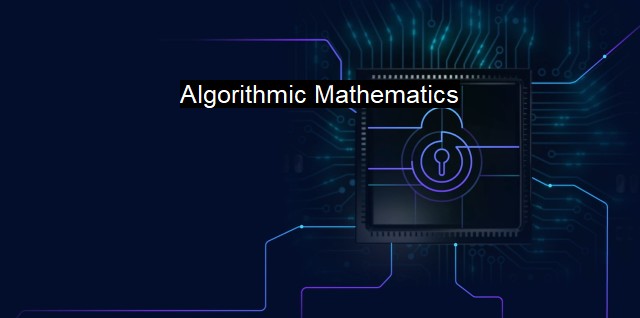What are Algorithmic Mathematics?
Enhancing Cybersecurity and Antivirus Software through Algorithmic Mathematics: An Exploration of Anomaly-based Detection and Machine Learning
Algorithmic mathematics, also known as computational or algorithms mathematics, refers to the application of mathematical models and abstractions to create, analyze, and apply algorithmic constructs. These constructions are utilized in a multitude of scientific areas, including cybersecurity.The etymology of the term comes from the Latin word 'algorithmus,' which refers to the step-by-step procedure for calculations, where a problem, through sequential steps, is resolved. Similarly, when it pertains to mathematics, an algorithm is a defined set of mathematical instructions that, if trailed properly, have the ability to solve problems directly or indirectly related to mathematics.
In the arena of cybersecurity, algorithmic mathematics constitutes a significant position because it assists in the decryption of codes, including cryptographic algorithms and network security protocols. The application of these mathematical algorithms yields improved security standards, ensuring the protection of essential data in the digital age. The fields of system security, information security, encryption, data privacy, and computer networks highlight the role of mathematical algorithms in ensuring effective and efficient cybersecurity.
Cybersecurity professionals employ algorithmic mathematics to develop advanced encryption methodologies. These sophisticated encryption schemes protect computer systems and networks from unwanted invasions, data breaches, and hacking attempts. As the nature and volume of cyber threats evolve, the selection and application of robust mathematical algorithms remain crucial.
Similarly, in antivirus software, algorithmic mathematics helps by delivering advanced threat detection and removal capabilities. Antivirus programs use heuristic detection algorithms that can identify viruses and other malicious software based on patterns and attributes, rather than relying on pre-existing virus definition databases.
These algorithms are generally mathematical models that can recognize, classify, and categorize various data groups and patterns. If the algorithm identifies any unusual activity, a signal is sent to the antivirus software to analyze the data further and even remove the suspected file if found malicious.
The antivirus software contains clusters of self-learning algorithms, even leveraging technology such as machine learning. These algorithms are used to increase the accuracy of virus identification, classification, and removal, and to reinforce the antivirus system's overall protective capabilities.
Artificial intelligence and machine learning algorithms have introduced a fresh dynamism into cybersecurity and antivirus mechanisms. These AI-driven systems use mathematical algorithms for profound learning from the extracted data. They make antivirus systems adept at determining unusual patterns and acting instantly, ensuring robust cybersecurity.
Apart from threat detection and protection, mathematical algorithms in cybersecurity play a pivotal role in various areas like key generation in encryption/decryption processes, cryptanalysis, biometric recognition, intrusion detection, and blockchain accounting. The strength of cryptographic keys and the safety of cryptographic procedures are deeply linked to algorithmic mathematics, ensuring the confidentiality and integrity of protected information.
In onion routing techniques, used for preserving privacy in a network, mathematical algorithms encrypt data at multiple layers. Symmetric key cryptography, aiming for secured data transmission, utilizes mathematical functions for creating unique keys for encrypting/decrypting data.
Modern hashing algorithms in cybersecurity are a prominent example of using mathematical algorithms for securing passwords by transforming them into irreversible cryptographic representations. Through duck test algorithms, heuristic threat detection becomes possible, whereby the antivirus program can detect undefined viruses based on their behavior patterns.
While existing on the backend of cybersecurity systems and antivirus programs, algorithmic mathematics stands as the central pillar supporting these robust defenses. By modeling, predicting, and understanding patterns and behaviours within data, mathematical algorithms enable cybersecurity initiatives to thrive, permitting continuous development and application of new defensive strategies. These principles allow for new standards of data exploration, granting cybersecurity and antivirus designs an ever-evolving armory to overcome the challenges of the digital age.

Algorithmic Mathematics FAQs
What is algorithmic mathematics in the context of cybersecurity?
Algorithmic mathematics refers to the use of mathematical algorithms in the field of cybersecurity to develop and improve antivirus software. It involves the creation of mathematical models and formulas to detect and prevent malicious activities in computer systems.How does algorithmic mathematics help in antivirus software development?
Algorithmic mathematics helps in antivirus software development by providing a way to analyze vast amounts of data quickly and accurately. It enables the software to detect and block malicious activities by recognizing patterns that are typical of malicious code.What skills are required for algorithmic mathematics in cybersecurity?
To work in algorithmic mathematics in cybersecurity, you need strong skills in mathematics, computer science, and programming. You should be able to design and implement algorithms, work with data structures, and have experience in machine learning and statistical analysis.How can I learn algorithmic mathematics for cybersecurity?
You can learn algorithmic mathematics for cybersecurity by taking courses in mathematics, computer science, and cybersecurity. There are also many online resources available, such as books, videos, and tutorials, that can help you gain the necessary knowledge and skills. Practicing with real-world examples can also be helpful in mastering the subject.| | A | | | B | | | C | | | D | | | E | | | F | | | G | | | H | | | I | | | J | | | K | | | L | | | M | |
| | N | | | O | | | P | | | Q | | | R | | | S | | | T | | | U | | | V | | | W | | | X | | | Y | | | Z | |
| | 1 | | | 2 | | | 3 | | | 4 | | | 7 | | | 8 | | |||||||